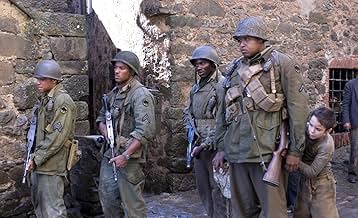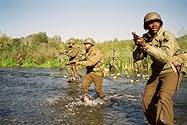ÉVALUATION IMDb
6,1/10
19 k
MA NOTE
Italie, 1944. L'histoire de quatre soldats américains noirs piégés dans un village de Toscane pendant la Seconde Guerre mondiale.Italie, 1944. L'histoire de quatre soldats américains noirs piégés dans un village de Toscane pendant la Seconde Guerre mondiale.Italie, 1944. L'histoire de quatre soldats américains noirs piégés dans un village de Toscane pendant la Seconde Guerre mondiale.
- Prix
- 1 victoire et 10 nominations au total
Lidia Biondi
- Natalina
- (as Lydia Biondi)
Histoire
Le saviez-vous
- AnecdotesSamuel L. Jackson turned down the offer to play as Corporal Hector Negron to work on Harcelés (2008).
- GaffesWhen the professor examines the marble head he recognizes it as the "Primavera" from Santa Trinità in Florence. He assumes it is by Bartolomeo Ammannati, but the bridge is by Ammannati; the sculpture is by Pietro Francavilla.
- Citations
Livingston: Safety is the greatest risk of all, because safety leaves no room for miracles and miracles are the only sure thing in life.
- Bandes originalesFaccetta Nera
Written by Gustavo Cacini (as Cascini) / Giuseppe Micheli (as Micheli) / Vincenzo Raimondi / Arnaldo Stazzonelli (as Stazzonelli)
Edizioni Bixio C.E.M.S.A.
Commentaire en vedette
Sometimes a true-blue filmmaker, full of art-filled aspirations and good intentions, isn't always the best judge of what will ultimately really work for the story. This has happened to Spike Lee on more than one occasion- this taking aside the fact that he has consistently puffed-up many of his films lenght-wise- and in Miracle at St. Anna he makes an admirable, powerful stumble. It's not embarrassing like Bamboozled or just laughable like She Hate Me; he has a goal here, and it's worth trying out. The message is made right in the first scene: John Wayne war movies are propagandistic drek that show really only one side. Spike Lee's 'version' of black soldiers embedded in a Tuscan village in WW2 is meant to be an antidote to all of those pompous, (practically) white-only war pictures. The problem is that he hasn't done much to advance the genre, or break out of anything really interesting with the bulk of the characters.
Ironic then that Lee should criticize Clint Eastwood's Flags of Our Fathers since both films suffer from similar faults: they're too long, too convoluted, occasionally far too schmaltzy, and whether by partnership (being co-produced by Spielberg himself) or just ripping-off, Saving Private Ryan is evoked more than once in the battle scenes. In the case of Lee's film, he also isn't entirely sure always how he wants to ground the picture: is it about the black soldiers on their quagmire of sorts, or about the little boy who nicknames the big friendly black soldier "Chocolate Giant", or about Partisans and their daring-do and corruption alongside the Nazi's? Or is it about believing in frigging miracles? Lee wants it to be about all of these things, and has made the running time of 160+ minutes so that he can fit as much as possible with pretty much anything and everything from James McBride's book packed in (this even includes anachronisms, like a German officer referring to the Geneva conventions!)
And while it is easy to criticize Lee for putting in so much, and overcrowding the mid-section of his picture (and eventually coming to some real head-scratching, groan-inducing bits towards the very end), there is passionate film-making on display. There are chunks that are compelling, that do convey the blatant racism that was pervasive at the time for anyone with dark skin color (albeit Lee stuffs in next to no white people who aren't dumb bigots), and the as-a-given brutality of the Nazi war machine. There's one particular scene, I should note where an entire town is massacred, that delivers the devastating effect Lee wants, and there are a couple others like it that deliver the visceral reaction intended with modern war pictures.
For all of its faults, for all of its hackneyed acting- including one guy who seems like a WW2 version of the Alpa Chino character from Tropic Thunder complete with gold tooth- and bits involving a precocious kid communicating by tapping, and for its mind-boggling plot twists, it is often well-directed and conscious of its message. It's a disappointment, to be certain, but there's worse. 5.5/10
Ironic then that Lee should criticize Clint Eastwood's Flags of Our Fathers since both films suffer from similar faults: they're too long, too convoluted, occasionally far too schmaltzy, and whether by partnership (being co-produced by Spielberg himself) or just ripping-off, Saving Private Ryan is evoked more than once in the battle scenes. In the case of Lee's film, he also isn't entirely sure always how he wants to ground the picture: is it about the black soldiers on their quagmire of sorts, or about the little boy who nicknames the big friendly black soldier "Chocolate Giant", or about Partisans and their daring-do and corruption alongside the Nazi's? Or is it about believing in frigging miracles? Lee wants it to be about all of these things, and has made the running time of 160+ minutes so that he can fit as much as possible with pretty much anything and everything from James McBride's book packed in (this even includes anachronisms, like a German officer referring to the Geneva conventions!)
And while it is easy to criticize Lee for putting in so much, and overcrowding the mid-section of his picture (and eventually coming to some real head-scratching, groan-inducing bits towards the very end), there is passionate film-making on display. There are chunks that are compelling, that do convey the blatant racism that was pervasive at the time for anyone with dark skin color (albeit Lee stuffs in next to no white people who aren't dumb bigots), and the as-a-given brutality of the Nazi war machine. There's one particular scene, I should note where an entire town is massacred, that delivers the devastating effect Lee wants, and there are a couple others like it that deliver the visceral reaction intended with modern war pictures.
For all of its faults, for all of its hackneyed acting- including one guy who seems like a WW2 version of the Alpa Chino character from Tropic Thunder complete with gold tooth- and bits involving a precocious kid communicating by tapping, and for its mind-boggling plot twists, it is often well-directed and conscious of its message. It's a disappointment, to be certain, but there's worse. 5.5/10
- Quinoa1984
- 26 sept. 2008
- Lien permanent
Meilleurs choix
Connectez-vous pour évaluer et surveiller les recommandations personnalisées
Détails
- Date de sortie
- Pays d’origine
- Site officiel
- Langues
- Aussi connu sous le nom de
- Miracle at St. Anna
- Lieux de tournage
- sociétés de production
- Consultez plus de crédits d'entreprise sur IMDbPro
Box-office
- Budget
- 45 000 000 $ US (estimation)
- Brut – États-Unis et Canada
- 7 919 117 $ US
- Fin de semaine d'ouverture – États-Unis et Canada
- 3 477 996 $ US
- 28 sept. 2008
- Brut – à l'échelle mondiale
- 9 333 654 $ US
- Durée2 heures 40 minutes
- Couleur
- Mixage
- Rapport de forme
- 2.39 : 1
Contribuer à cette page
Suggérer une modification ou ajouter du contenu manquant

Lacune principale
By what name was Miracle à Santa Anna (2008) officially released in India in English?
Répondre




























